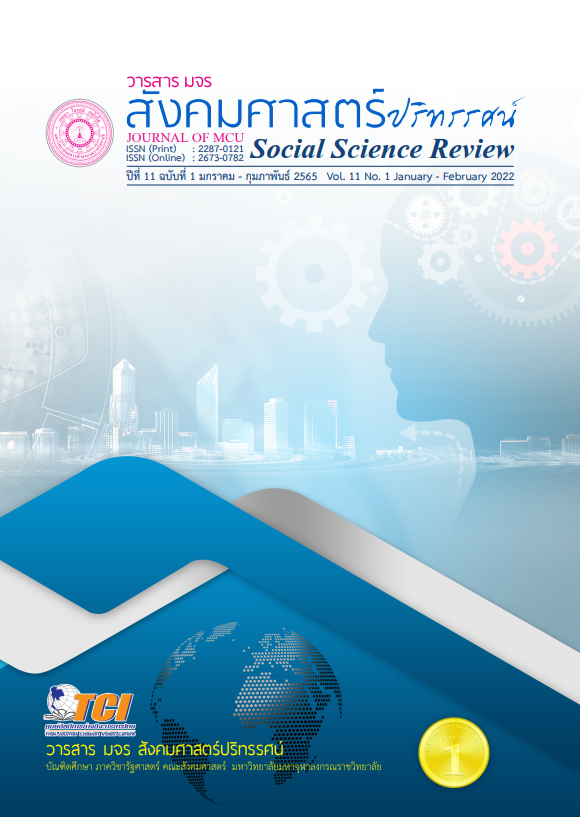แนวทางการพัฒนาเขตเศรษฐกิจพิเศษจังหวัดกาญจนบุรี-ท่าเรือน้ำลึกทวาย ภายใต้ผลประโยชน์ ความขัดแย้ง อำนาจทางการเมือง และความสัมพันธ์ระหว่างประเทศ
คำสำคัญ:
เขตเศรษฐกิจพิเศษ, ผลประโยชน์และความขัดแย้ง, ความสัมพันธ์ระหว่างประเทศบทคัดย่อ
บทความวิจัยนี้มีวัตถุประสงค์เพื่อ 1. ศึกษาบริบททางด้านผลประโยชน์ฯ 2. วิเคราะห์ประเด็นด้านผลประโยชน์ฯ กับการพัฒนาเขตเศรษฐกิจพิเศษ 3. แนวทางการพัฒนาเขตเศรษฐกิจพิเศษ ใช้วิธีวิจัยเชิงคุณภาพ ศึกษาเอกสาร การสัมภาษณ์เจาะลึกผู้ให้ข้อมูลสำคัญ จำนวน 25 คน จัดกลุ่มสนทนา จำนวน 10 คน วิเคราะห์ข้อมูลเชิงเนื้อหาและส่วนประกอบ และตรวจสอบข้อมูลแบบสามเส้า
ผลการวิจัยพบว่า 1. บริบทด้านผลประโยชน์ เขตเศรษฐกิจพิเศษท่าเรือน้ำลึกทวายครอบคลุมการจัดตั้งเป็นเขตพื้นที่ส่งเสริมสนับสนุน อำนวยความสะดวกด้านการค้าและการลงทุน ความขัดแย้ง ด้านผลประโยชน์การใช้พื้นที่ อำนาจทางการเมือง การจัดตั้งเขตเศรษฐกิจพิเศษมีความชอบธรรม ความสัมพันธ์ระหว่างประเทศอยู่ในรูปของการเชื่อมโยงระหว่างกลุ่มประเทศ 2. วิเคราะห์ด้านผลประโยชน์ พบว่า 1) การรับมือกับสภาพแวดล้อมที่เปลี่ยนแปลง 2) ประโยชน์และผลกระทบต่อภาคเอกชน และ 3) การสร้างระบบที่เอื้อต่อการพัฒนา ปัญหาความขัดแย้ง เกิดจากโครงสร้างประชากร 3. แนวทางการพัฒนา ได้แก่ 1) การพัฒนาการขยายฐานสำหรับการค้าน้ำมันดิบ 2) เพิ่มการกระจายการส่งออกเป็นประตูเศรษฐกิจ 3) ท่าเรือน้ำลึกทวายเป็นช่องทางการขนส่งทางทะเล 4) การใช้แรงงานพม่า 5) การขยายตัวทางเศรษฐกิจในภูมิภาค 6) ยกระดับการจัดการสินค้าคงคลังด้วยกระบวนการห่วงโซ่อุปทาน และ 7) การขยายเครือข่ายโลจิสติกส์โดยรวบรวมเส้นทางการค้าและการขนส่งใหม่
เอกสารอ้างอิง
กิตติพล โชติพิมาย. (2551). การจัดตั้งเขตเศรษฐกิจพิเศษชายแดนบริเวณจังหวัดสงขลา ประเทศไทย-รัฐเกดะห์ มาเลเซีย. วารสารเศรฐกิจและสังคม, 12(1), 77-88.
กลุ่มงานพื้นที่เศรษฐกิจชายแดน. (2557). แนวทางการพัฒนาเขตพัฒนาเศรษฐกิจพิเศษของประเทศไทย. วารสารเศรษฐกิจและสังคม, 51(4), 78-89.
กรมเจรจาการค้าระหว่างประเทศ. (2556). AEC Fact Book. กรุงเทพฯ: กรมเจรจา การค้าระหว่างประเทศ กระทรวงพาณิชย์.
โกสุมภ์ สายจันทร์ และ อัจฉรียา สายศิลป์. (2557). ประชาสังคมข้ามพรมแดนและโครงการพัฒนาขนาดใหญ่ระหว่างประเทศในสหภาพเมียนมาร์ : กรณีศึกษาโครงการพัฒนาท่าเรือน้ำลึกและนิคมอุตสาหกรรมทวาย. เชียงใหม่: คณะรัฐศาสตร์และรัฐประศาสนศาสตร์ มหาวิทยาลัยเชียงใหม่.
ชูศักดิ์ จรูญสวัสดิ์. (2548). ระบบเศรษฐกิจและพัฒนาการเศรษฐกิจไทย (พิมพ์ครั้งที่ 3). กรุงเทพฯ: โรงพิมพ์ ส.เสริมมิตรการพิมพ์.
เรวดี แก้วมณี. (2556). ส่องความคืบหน้ากฎหมายเดินเครื่อง “เขตเศรษฐกิจพิเศษ”. กรุงเทพฯ : สำนักนโยบายอุตสาหกรรมมหภาค (สม.).
วิภาวดี พันธุ์ยางน้อย. (2560). บทบาทของภาคประชาสังคมพม่าภายหลังการเลือกตั้งทั่วไปปี 2010 กรณีศึกษา โครงการเขตเศรษฐกิจพิเศษและท่าเรือน้ำลึกทวาย ประเทศพม่า. กรุงเทพฯ: สำนักงานกองทุนสนับสนุนการวิจัย
วริศรา ภานุวัฒน์. (2556). เขตเศรษฐกิจพิเศษทวาย. กรุงเทพฯ: แสงดาว.
Carvalho, S., & White, H. (1997). Combining the quantitative and qualitative approaches to poverty measurement and analysis: The practice and the potential. World Bank Technical Paper 366. Washington, D.C.: World Bank.
Chaisse, J., & Ji, X. (2020). The Pervasive Problem of Special Economic Zones for International Economic Law: Tax, Investment, and Trade Issues. World Trade Review, 19(4), 567- 588.
Pakdeenurit, P. et al. (2017). Location and key success factors of special economic zone in Thailand. Marketing and Branding Research. 4(2), 169-178.
ดาวน์โหลด
เผยแพร่แล้ว
รูปแบบการอ้างอิง
ฉบับ
ประเภทบทความ
สัญญาอนุญาต
ลิขสิทธิ์ (c) 2022 วารสาร มจร สังคมศาสตร์ปริทรรศน์

อนุญาตภายใต้เงื่อนไข Creative Commons Attribution-NonCommercial-NoDerivatives 4.0 International License.
เพื่อให้เป็นไปตามกฎหมายลิขสิทธิ์ ผู้นิพนธ์ทุกท่านต้องลงลายมือชื่อในแบบฟอร์มใบมอบลิขสิทธิ์บทความให้แก่วารสารฯ พร้อมกับบทความต้นฉบับที่ได้แก้ไขครั้งสุดท้าย นอกจากนี้ ผู้นิพนธ์ทุกท่านต้องยืนยันว่าบทความต้นฉบับที่ส่งมาตีพิมพ์นั้น ได้ส่งมาตีพิมพ์เฉพาะในวารสาร มจร สังคมศาสตร์ปริทรรศน์ เพียงแห่งเดียวเท่านั้น หากมีการใช้ภาพหรือตารางหรือเนื้อหาอื่นๆ ของผู้นิพนธ์อื่นที่ปรากฏในสิ่งตีพิมพ์อื่นมาแล้ว ผู้นิพนธ์ต้องขออนุญาตเจ้าของลิขสิทธิ์ก่อน พร้อมทั้งแสดงหนังสือที่ได้รับการยินยอมต่อบรรณาธิการ ก่อนที่บทความจะได้รับการตีพิมพ์ หากไม่เป็นไปตามข้อกำหนดเบื้องต้น ทางวารสารจะถอดบทความของท่านออกโดยไม่มีข้อยกเว้นใดๆ ทั้งสิ้น





